#iris orthodoxy
Explore tagged Tumblr posts
Text
the new Iris girls have a distinctive rigging and i love that.


Mogador and Alsace respectively. their rigging looks unique, just like Brennus:

My main concern, and the concern of many to be fair, was that the Iris Orthodoxy and the Royal Navy had begun to share a lot of visual elements in terms of rigging. These new gals look... "anime catholic mecha", while Royal Navy's most recent shipgirls look "anime christian knight"

here's Royal Oak's full design. other than being incredibly pretty, i think she's distinctive enough from the most recent Iris event. Hell, here's Marseillaise for comparison too

you can tell Marseillaise has the same style that Alsace has, which is just an evolved early Iris rigging style, and i think that's distinctive enough.
#azur lane#gacha game#gacha#royal navy#iris orthodoxy#iris libre#vichya dominion#azur lane 7th cn anniversary#azur lane cn anniversary
11 notes
·
View notes
Text
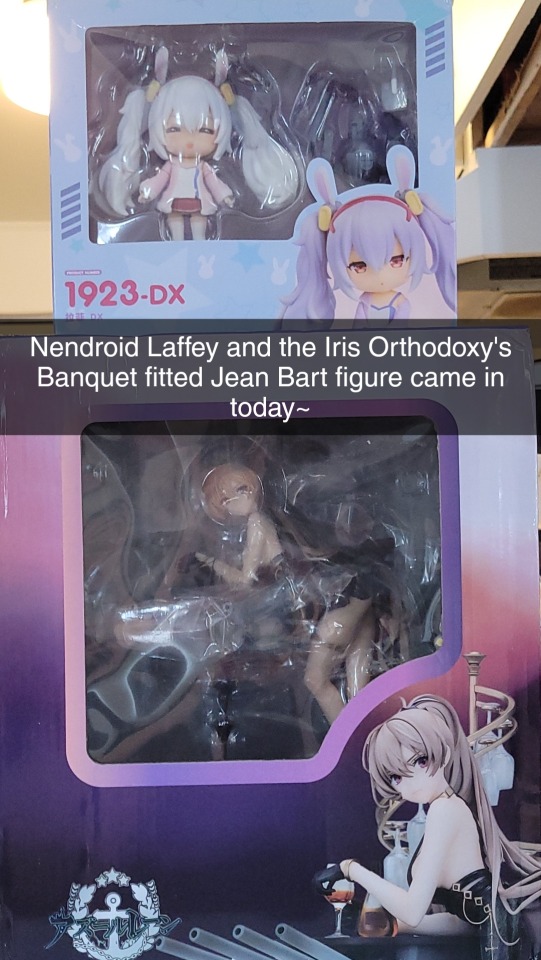
#azur lane#laffey#jean bart#eagle union#iris orthodoxy#5th anniversary#nendroid#anime figures#vichya dominion
10 notes
·
View notes
Photo

Today we celebrate the Holy Hierarch Gregory of Nyssa. Saint Gregory, the younger brother of Basil the Great, illustrious in speech and a zealot for the Orthodox Faith, was born in 331. His brother Basil was encouraged by their elder sister Macrina to prefer the service of God to a secular career (see July 19); Saint Gregory was moved in a similar way by his godly mother Emily, who, when Gregory was still a young man, implored him to attend a service in honor of the holy Forty Martyrs at her retreat at Annesi on the River Iris. Saint Gregory came at his mother's bidding, but being wearied with the journey, and feeling little zeal, he fell asleep during the service. The Forty Martyrs then appeared to him in a dream, threatening him and reproaching him for his slothfulness. After this he repented and became very diligent in the service of God. Gregory became bishop in 372, and because of his Orthodoxy he was exiled in 374 by Valens, who was of one mind with the Arians. After the death of Valens in 378, Gregory was recalled to his throne by the Emperor Gratian. He attended the Local Council of Antioch, which sent him to visit the churches of Arabia and Palestine, which had been defiled and ravaged by Arianism. He attended the Second Ecumenical Council, which was assembled in Constantinople in 381. Having lived some sixty years and left behind many remarkable writings, he reposed about the year 395. The acts of the Seventh Ecumenical Council call him 'Father of Fathers." May he intercede for us always + Source: https://www.goarch.org/chapel/saints?contentid=379 (at Harmandalı, Kırşehir, Turkey) https://www.instagram.com/p/CnNW4_FhkqK/?igshid=NGJjMDIxMWI=
6 notes
·
View notes
Text

"And that is how the Iris Orthodoxy divided into the Iris Libre and Vichy Dominion." Sage nod.
41 notes
·
View notes
Text
Also a special Thank You to F’hana Rihll without whom we’d not have our Consulate
Saint F’hana might be too much to ask of the Orthodoxy, but Iris will work on it.
6 notes
·
View notes
Text

DONT F*ING TOUCH ME!
The Fool: The highest and lowest trump. The Fool is interpreted as the protagonist of a story, and the Major Arcana are the path the Fool takes through the great mysteries of life. This path is known traditionally in cartomancy as the "Fool's Journey". The Fool card is associated with: Folly, mania, extravagance, intoxication, delirium, frenzy, bewrayment. The Wheel: A common aspect to most interpretations of this card within a reading is to introduce an element of change in the fool's life, such change being in station, position or fortune: such as the rich becoming poor, or the poor becoming rich. This Tarot reminds you that nothing is permanent, and, good or bad, you must cherish the lessons that this moment is bringing you. The Hierophant stands for righteousness, sacredness, hierarchical order, orthodoxy, and moral righteousness. He is an exoteric figure, like a messenger from the heavens. He is experienced in spirituality and guidance and his job is to bring these lessons down to us here in the real world. The Star is the embodiment of hope and healing. She is a calming influence that brings messages of renewal, optimism, and inspiration. When The Star comes up in your Tarot reading, she reminds you that the universe is working in your favor, and encourages you to have faith in where you are being taken. Temperance: usually referred to as the virtue Temperance or as an angel, it is possible that the figure could also be the goddess Iris or even the archangel Michael. Along with Justice and Strength, it is one of three Virtues in tarot. Associated with economy, moderation, frugality, management, accommodation. It is master of moderation. She encourages peace and patience, and reminds you to go with the flow of your life instead of trying to force its pace or direction. The Moon card represents hidden thoughts, feelings, doubts and fears. When The Moon arises in your Tarot reading, you may be allowing your fears to override your faith in the future. Don't be deceived -- you can't believe everything that you see, hear, or think. If you can draw your feelings to the surface and address them, you can rid yourself of worry. The Devil: Ravage, violence, vehemence, extraordinary efforts, force, fatality; that which is predestined but is not for this reason evil. He carries themes of restraint and powerlessness. Causing the fool to likely feel stuck. The Devil has convinced you that you have no options, but this couldn't be further from the truth. You hold the keys to your own freedom, but it's up to you to open the lock.
We've got a better look at the new arcana outfits and some card names for the guys now!

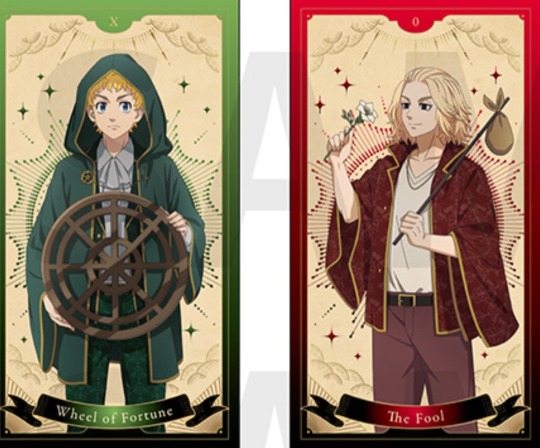
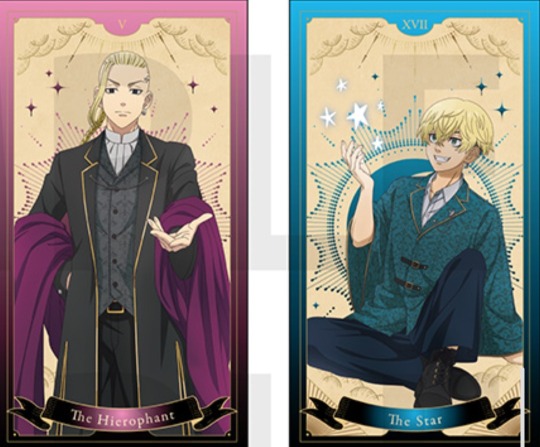
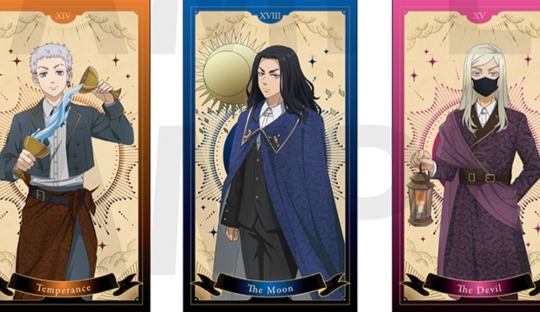
116 notes
·
View notes
Text
Nampō Roku, Book 3 (13): the Question of Using an Oki-dana in the Small Room.

13) On one occasion when Sōeki had entered the Shū-un-an [for a chakai]¹, in the fuka san-jō [深三疊] with the mukō-ro [向う爐] he noticed a [chū-ō-]joku placed on the kagi-datami [かぎ疊]².
[At the beginning of] the hatsu-iri [初入]³, on the upper [shelf] was a celadon censer⁴, [while] below was the mizusashi; and the fukusa was tied to the leg [of the joku]. Then, collected together on a tray, [I⁵] brought out the kōgō, taki-gara-ire [たきから入], and kō-bashi [香ばし]⁶; and [then] one piece [of incense] was burned⁷.
Afterward⁸, the chaire was [displayed] above, while below, the mizusashi and futaoki were arranged together [on the lower shelf]. And while tea was being served according to [the usage associated with] this [arrangement], [Sō]eki said:
“On the whole, when using the mukō-ro, [for the host to consider using] things like a joku or tana -- isn’t it the first [rule] that [we] should not make [the utensil mat appear] so congested? And on top of this, when raising and lowering the kama [during the sumi-temae], or when the hishaku moves from the mizusashi to the kama, and so forth, it becomes nearly impossible [to execute] many of these actions [appropriately in this sort of setting]¹¹.
“[Consequently,] you must understand that it is exclusively the case that the [chū-ō-]joku, and the [various] tana, are reserved for [use in] rooms larger than 4.5-mats, and should never be placed [in rooms of the present sort]¹². [Adhering to this as a principal,] there will therefore be no error in what we do.”
[We] are overcome with emotion [over the wonder of this teaching], and prostrate ourselves [to Rikyū, in thanks]¹³.
_________________________
¹Aru toki, Sōeki wo Shū-un-an [h]e mōshi-ireshi ni [ある時、宗易を集雲庵へ申入しに].
The beginning phrases of the first sentence read like one of the entries in Book One, marking this entry as being completely out of place in the present book.
Furthermore, the content of this passage is questionable on several levels:
- first, it shows that the author (whom, if it were Nambō Sōkei himself -- as alleged -- would make the entry patently nonsensical) was ignorant of the geography of the Shū-un-an -- since the two three-mat rooms have been conflated (according to the details of this room, as related in Book Two, the older of them featured a mukō-ita -- a board that replaced the far 1-shaku 5-sun of the utensil mat, and a mukō-ro would be cut in front of it, making it impossible to put a tana next to the ro; but the other room, which lacked this board, had the ro cut in one of the adjoining mats, hence it was not a mukō-ro)*;
- secondly, it ignores the fact that Rikyū originally created the kyū-dai [休臺]† precisely so that it could be placed next to a mukō-ro in a three-mat room, meaning that Rikyū could hardly chide Sōkei for doing something for which he himself had established the precedent (especially in the words used)‡;
- and, third, while the date of this alleged interaction is unknown, it seems to overlook the fact that the Shū-un-an had a tsuri-dana attached to the wall in the corner of the room (at least since the end of 1582)**, making it unnecessary for the host to have a reason for wanting to use an oki-dana.
All of which marks this entry as even more blatantly spurious than usual for Book Three of the Nampō Roku††.
This is one of only six entries from Book Three that Kumakura Isao included in his supposedly complete modern-Japanese version of the Nampō Roku (Nampō Roku wo Yomu [南方録を読む])‡‡, and, as might be expected, he appears to use it as yet another “proof” of the inherent veracity of his school’s teachings. __________ *This means that a mukō-ro would have had to be cut in front of the board, on a daime-sized mat, as shown below -- though doing so would have made it impossible for an oki-dana to be placed next to the ro (since there would be insufficient space for the kama and sumi-tori to be placed in front of the tana during the sumi-temae), as is obvious from the sketch.
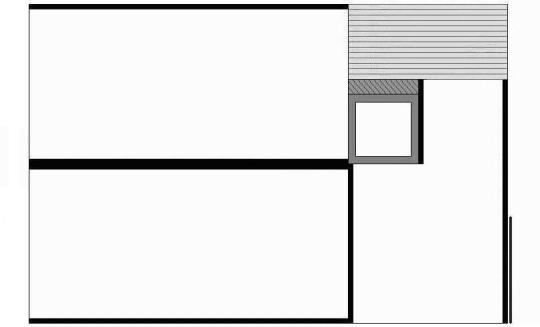
Rikyū used this room during the chakai described in the post entitled Nampō Roku, Book 2 (40): (1587) Sixth Month, Second Day, Morning. The URL for that post is:
https://chanoyu-to-wa.tumblr.com/post/183593009914/namp%C5%8D-roku-book-2-40-1587-sixth-month
†Rikyū's eponymous kyū-dai [休臺; the name would now be written 休台] collectively refers to the two tana that we know as the shi-hō-dana [四方棚] (also pronounced yo-hō-dana by people who have been conditioned to associate the sound “shi” with the word for death -- though Rikyū and the men of his generation do not seem to have had this problem) and the maru-joku [丸卓].
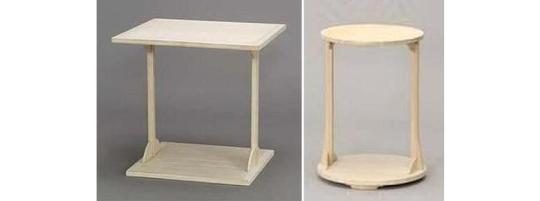
The shi-hō-dana [四方棚], which seems to have been the first to have been created of the two, was intentionally made to be placed next to a mukō-ro. Its dimensions correspond to the space available to the left of the ro just as the kyū-dai daisu [及第臺子] (from which it was derived) does to the full mat: that is, the ten-ita extends from heri to heri, while the ji-ita is 2-me (1-sun) shy of the heri on both sides (the ten-ita of the kyū-dai daisu measures 2-shaku 9-sun 5-bu wide -- which is the same as the space between the heri on a kyō-ma tatami -- by 1-shaku 4-sun deep; the ji-ita measures 2-shaku 7-sun 5-bu wide by 1-shaku 3-sun deep).
◎ Note that the Sen family modified the dimensions of the shi-hō-dana during the early Edo period, perhaps to confuse its origins, or confound Rikyū’s original usage (their version will not fit in the space available beside the mukō-ro); however, the “Rikyū shi-hō-dana” (as it is known in the utensil trade) is still seen from time to time, and it confirms Rikyū's intentions.
The maru-joku [丸卓] (the name comes from the Edo period; Rikyū referred to this tana as a kyū-dai as well) was intended to be placed next to a ko-ita furo (the tana raises the mizusashi to the same height it would have had if placed on the daisu) in the same kind of setting. (Note that a large furo, such as the large iron kimen-buro, is what was supposed to be placed on a ko-ita; and when this is done, the mouth of the kama is the same height -- above the mats -- as that of a kama resting on a medium-sized furo arranged on the daisu. Rikyū was initiated into chanoyu by Kitamuki Dōchin, and the relationships between the utensils determined by the daisu forever influenced his chanoyu.)
It seems that Jōō and Rikyū felt that the 3-mat room was the transitional stage between the shoin (which both he and Jōō held to be the 4.5-mat room) and the small room (2-mat).
‡It seems to have (perhaps, fairly frequently) been the case that people (who had studied with Rikyū, and later whose father or other ancestor had studied with Rikyū) challenged the orthodoxy of the Sen family's teachings. Which, in turn, prompted them to create these deceptions -- rather than simply admit that their machi-shū approach was deficient (and sometimes, simply wrong). In fact, this would have not been very problematic, at least at first, since it was well known to the chajin of his day that Sōtan had a very limited exposure to chanoyu, a consequence of his family's poverty, coupled with his own disinclination to associate himself with those wealthy persons who could have lifted up his condition.
For most of his life, Sōtan seems to have used only the (third) small unryū-gama in the broken old Temmyō kimen-buro (resting on the unglazed gray floor tile that Furuta Sōshitsu had brought back from Korea), or suspended over the ro on a bamboo jizai, with a kiji-tsurube as his mizusashi, an old Hagi bowl that had previously been used for rinsing writing brushes (and so was darkly stained with ink) as his chawan, and a natsume that he had made himself from lacquered paper, tied in a handmade blue paper shifuku. Consequently, there was no reason why he should have known about anything other than the simplest style of chanoyu. Yet rather than admitting to what everyone already knew was true, he (or his handlers, the Tokugawa bakufu) preferred to challenge Rikyū's teachings, and override them as wrongly-remembered fictions.
We see the same thing even today, when certain schools deny that Rikyū's writings are legitimate (because they differ from what those schools prefer to teach), and put their own words in Rikyū's mouth -- all while worshiping him as their tea god.
The same is true when these schools talk about the Nampō Roku. On the one hand, they discount this collection of teachings as a blatant forgery; and on the other, they cherry pick its contents, highlighting those parts that appear to support their school's version of this or that teaching, while patently ignoring the rest (as if it never existed).
**The Shū-un-an dana [集雲庵棚] (which is the technical name for a tsuri-dana suspended in the corner of a room, rather than attached to a sode-kabe on the side of the mat adjacent to the ro) is presumed to have been added shortly after Rikyū created the tsuri-dana (in the Tai-an [待庵] room, at the Myōgi-an, in Yamazaki, Kyōto, during the summer of 1582) -- though the date of its original appearance in the Shū-un-an is completely undocumented (the earliest descriptions of the Shū-un-an, which date from the early Edo period, mention the presence of the tsuri-dana in the corner of the room; but this is, of course, long after the fact). Rikyū's tsuri-dana was intended to replace the fukuro-dana (which, up to then, was commonly -- though not always -- installed within the kamae), hence the necessity of its being on the right side of the mat, adjacent to the ro.
If, however, the Shū-un-an dana came first (as a substitute for a small oki-dana, such as the maru-joku, that was placed next to a ko-ita furo -- or a chū-ō-joku, next to a mukō-ro, as described in this episode), this would have been, historically speaking, most interesting.
††Suggesting that it was added by a different hand from the one responsible for “editing” the original book. Because this passage alludes to one of the Sen family's cardinal principals, it seems likely that one of their agents was responsible for adding this entry to Book Three. (The bakufu, on the other hand, would probably not have ventured to register this kind of objection, since their purpose was in encouraging the use of as many utensils as possible.)
‡‡Since it furthers his purpose of showing that the Nampō Roku “validates” modern Urasenke teachings, reinforcing the notion that Urasenke disseminates the original Rikyū-derived version of chanoyu.
²Fuka san-jō mukō-ro, kagi-datami ni joku wo okite [深三疊向爐、かぎ疊に卓を置て].
The expression kagi-datami [鍵疊] refers to the mat (regardless of whether it is the utensil mat, or a mat that adjoins it*) in which the ro has been cut.

In Nambō Sōkei's own room in the Shū-un-an (which was usually where he entertained his guests), the ro was cut in one of the mats to the right of the utensil mat, as shown in the photos of Kanshū oshō-sama’s reconstruction (above)†, and in the sketch of the original (below, which shows the room as it may have been used during the furo and ro seasons -- though it is possible that Nambō Sōkei used the ro all year round), which would make that mat the kagi-datami. However, it is impossible that a tana would have been placed on that mat.

On the other hand, if this entry is, referring to the historical room that had apparently been erected as the residence of Giō Jōtei [岐翁紹禎]‡ (the room with a mukō-ita replacing the far end of the utensil mat**), while a mukō-ro may have been present, its being cut in front of the mukō-ita would mean that there would have been insufficient space for the host to perform the sumi-temae if a chū-ō-joku was placed to the right of the mukō-ro. (During the furo season, the furo and other utensils would have been placed on the mukō-ita, at the head of the utensil mat; a mukō-ro, if one were cut in this room, as shown in the sketch on the right, would have been located in front of this ita-datami, turning the utensil mat into a daime, meaning it would have been used much like the discredited ichi-jō-han [一疊半] room)

In either case, it is difficult to reconcile historical reality with the details of this entry††. __________ *That said, the term is more commonly employed to designate one of the other mats in the room, rather than the utensil mat. The square mat in the middle of a 4.5-mat room is commonly referred to as the kagi-datami, as is the mat to the right of the utensil mat in a room of six or eight mats.
†According to the monks of the Nanshū-ji, the original Shū-un-an was looted by agents of the Imperial Army around 1930 (at the same time that agents of the Imperial Army attempted to loot, and then burned down, the Enkaku-ji in Fukuoka). Subsequently, they set fire to the building, while giving out that it had been destroyed by an American bombing raid. (The site is now occupied by a kindergarten run by Sakai city.)
Kanshū oshō-sama had visited the original Shū-un-an a decade or so before this incident, and recorded the room’s particulars in great detail. He built a replica of this structure when the Enkaku-ji was rebuilt during the 1950s (on a site granted to Kanshū oshō by the Shōfuku-ji, on land that had previously been a graveyard for secular commoners affiliated with that temple from the time when the Shōfuku-ji had been located within the Korean city-state of Hakata).
��Giō Jōtei [岐翁紹禎; c 1428 ~ ?] was the illegitimate son of the great Ikkyū Sōjun. It was he who established the Shū-un-an as his residence in his last years. Nambō Sōkei was the second resident monk of this compound.
**In the early days, this ita-datami [板疊] (a board that replaces part of the mat -- which Rikyū referred to as a mukō-heiban [向平板]) was used like the floor of the o-chanoyu-dana, with a large iron kimen-buro and the rest of the kaigu arranged on it. While it is possible that Nambō Sōkei (who was the second occupant of the complex) cut a ro in the floor of Giō’s room, it seems rather disrespectful (and so out of character) that he would have done so. (Rikyū is only mentioned as having used the room during the furo season, when, of course, the furo would have been placed on the mukō-ita, as originally intended by Giō Jōtei.)
††Access to the Shū-un-an was generally prohibited (since the room had been sealed by the Abbot of the Nanshū-ji as soon as Nambō Sōkei's suicide had become known to him); thus the chajin of the early Edo period would have been unaware of the issues which the errors in this material raise. (Indeed, the very secrecy with which Jitsuzan’s manuscript was treated implies that only persons absolutely willing to accept its contents as unequivocal fact would have been granted access to this material, coupled with the fact that it was forbidden to make copies, would have effectively dissuaded side discussions of these questionable details.)
³Hatsu-iri [初入].
Another word for the sho-za [初座].
If there is a difference* between the two terms, it is that hatsu-iri describes things from the host’s perspective, while sho-za refers to the division of the chakai from the guests’ side. __________ *Which, in practice, there is not.
⁴Seiji no kiki-kōro [青磁の聞香爐].
A Chinese celadon censer that was made to be held in the hand while appreciating kyara [伽羅] incense.

These censers were specially made, in China, for this specific purpose -- which is attested to by the fact that the three legs attached to the bottom are not spaced equally (there is a wider gap between the front leg and the one on the left, to allow for the insertion of the fingers of the left hand -- on which the kōro rests while it is supported on the side by the right hand, so it may be lifted up to the nose)*. Kōro not intended for this purpose have the legs that are carefully spaced around the base (so there is no discernible front). This is discussed in greater detail in Book Six of the Nampō Roku.
These censers were always fitted with a lid* (as seen in the photo) because the special ash that was used in them was stored in the censer itself when not in use (the lid, which was made of lacquer-rubbed wood or ivory, kept the ash clean, as well as dry, and allowed the ash to maintain a moisture content comparable to the kōro itself, preventing it from drawing in moisture that might smother the charcoal), which was then tied in a shifuku for storage. As with the temmoku, in Rikyū’s day it was common to remove the kiki-kōro from its shifuku before displaying it in the tearoom.
Nambō Sōkei seems to have been a collector of quality utensils. _________ *Modern antique dealers and tea-utensil merchants, unaware of the purpose, frequently consider such kōro misshapen -- thereby allowing knowledgeable individuals to purchase them at substantially reduced prices.
†Kōro made for burning incense to perfume the air of the room, or for perfuming clothing, are fitted (if any) with a fenestrated lid (to keep things from falling into the burning incense).
⁵The speaker is supposed to be Nambō Sōkei.
⁶Sate bon ni kōgō, taki-gara-ire, kō-bashi kumi-awasete hakobi-dasu [さて盆に香合、たきから入、香ばし組合セて運び出].
A taki-gara-ire [炷空入] is a small container, usually made of ceramic or, less frequently, cloisonné*, into which the used gin-yō [銀葉] (bearing the burned-out piece of kyara incense wood) is discarded after the appreciation of incense is concluded. The small ceramic containers that have been used as kōgō during the ro season since the days of Jōō (who is responsible for establishing this usage), such as Rikyū’s treasured ruri-suzume [瑠璃雀] (shown below), were originally used as taki-gara-ire.

The word kō-bashi [香ばし = 香箸] refers to what exponents of kōdō [香道]† call a kyōji [香筋]† -- small chopsticks made of ivory or ebony, and used to handle the pieces of kyara incense wood.
The gin-yō [銀葉] (mica squares on which the piece of kyara was set to smolder, thus keeping the ash clean) were traditionally placed in the kōgō together with the pieces of incense (the latter enclosed in a paper wrapper as described in the previous installment). __________ *Less frequently because cloisonné pieces can get hot when the gin-yō is discarded into them, thus potentially damaging the tray on which the taki-gara-ire is resting.
In fact, in the context of a chanoyu gathering, since the burning of incense in a hand-held censer takes the place of putting incense into the furo or ro, it has been customary (since the time of Jōō) for the kiki-kōro to be lifted into the tokonoma after the guests have finished appreciating it in their hands, so it can continue to perfume the room throughout the shoza (the purpose of which is to help obscure the smell of the combusting charcoal). Once again, this suggests that the person responsible for incorporating this material into Book Three of the Nampō Roku was a follower of the so-called machi-shū style of chanoyu champoined by Sōtan and his family, rather than a classically trained practitioner who had been a fellow of Jōō (as Nambō Sōkei certainly had been -- it must be remembered that Jōō gathered his early followers from among the ranks of the guests assembled for the Shino family's incense gatherings, and Sōkei seems to have been one of that number).
†In Rikyū's period, there was no Edo period prejudice that demanded that people remain exclusively within their own specialty. Rikyū and his fellow chajin were expected to be equally experienced in the details of appreciating incense (i.e., what is intended by the word kōdō today), flower arranging (ikebana), and even poetry (in the case of Jōō; though to a lesser extent Rikyū, perhaps on account of his dyslexia), as they were supposed to be trained in the serving of tea.
Nambō Sōkei, therefore, given his rank, would surely have been sufficiently educated that he would not have been guilty of this mistake in the basic terminology of incense. Indeed, it was precisely in order to expose this kind of fraud that, even when written “kō-bashi” [香筋], the word was supposed to be pronounced kyōji [きょうじ].
The person who wrote the text of this entry clearly was not a savant: a sense of laissez faire (from anything resembling the classical teachings) characterized Sōtan and his followers’ approach to chanoyu.
⁷Isshu taki [一炷たき].
Shu [炷] is used as the counting word for pieces of incense. That is, one piece of kyara was burned, and the censer was passed around three times; after which the appreciation of incense was concluded.
⁸Nochi ni ha [後には].
In other words, at the beginning of the goza.
⁹...Shosa tsukamatsuri-shi ni [所作仕しに].
Shosa [所作] refers to ones performance (in other words, the series of gesticulations employed while serving tea). This word was never used in this kind of context in Rikyū's period, and clearly dates this text to the Edo period -- as does the verb tsukamatsuru [仕る] (to serve or wait upon), in this context.
¹⁰Dai-ichi sewa-sewashikute funiai sōro ka [第一セわ〰しくて不似合候か].
Dai-ichi [第一] means first of all, in the first place.
Sewa-sewashikute [忙々しくて]: sewashikute [忙しくて] means to be busy, in the sense of looking too busy, or fussy, or (in this case) cluttered. Doubling sewa simply amplifies the negative sense of this expression.
Funiai [不似合] means unbecoming, improper, ill-matched, unsuitable -- to the setting.
In other words Rikyū is saying* that, in the case of the mukō-ro, it is inappropriate for the host to make the utensil mat look so cluttered. __________ *Though, after translating his densho, it is impossible to imagine that the man could have ever spit out this sentence.
¹¹Kama no age-oroshi, mizusashi yori kama [h]e hishaku hakobi nado mu-ri no hataraki ōshi [釜のあげおろし、水指より釜へひしやくはこびなど無理のはたらき多し].
Translated more literally, the sentence means “[with regard to] the lifting and lowering of the kama, [or] conveying the hishaku from the mizusashi to the kama, and the like, it becomes unrealistic [for one] to [attempt to] perform many of these actions.”
It appears that the author of this entry is thinking of chū-ō-joku, or other kinds of tana, that have four legs. Yet the classical teaching specifically stated that no tana of this sort was permitted to be used on the utensil mat, aside from the shin-daisu*: all other tana had to have two (or, at the most, three) legs†.
Now while it can be argued that the Hora-dana [洞棚], Sei-rō-dana [城樓棚], or taji [簞笥] (tabi-dansu [���簞笥])‡, all effectively have four legs (or the side projects forward far enough that it will interfere with the movement of the hishaku in the same way in such a case as is under discussion here), the tana that was created by Rikyū for use beside a mukō-ro was one with two legs, an intentional miniaturization of the kyū-dai daisu. And so a chū-ō-joku with two legs (or perhaps one with three -- since the hishaku moves around the front corner of the ro, rather than going directly from the mizusashi to the kama in a straight line) would not be objectionable.
As for the sumi-temae, it must be remembered that, since ancient times, the kiji-tsurube has been used as a mizusashi; and that the ancient rule was that the kiji-tsurube was to be set in its place on the utensil mat at dawn, and left there until the room was closed up for the night. So, aside from the initial placing of the fire into the cold ro at dawn (which was done just before the water was drawn from the well), all other sumi-temae (whether performed when the guests were present in the room, or in between gatherings, in order to maintain the heat of the kama throughout the day**) were undertaken with the tsurube sitting on the mat next to the mukō-ro (if that was the setting); and the tsurube would interfere with the kama in almost the same way as a tana -- meaning that the disposition of the sumi-tori and the kama in either case would have to be adjusted accordingly††.
Meanwhile, if the author is specifically imagining the arrangement where the mukō-ro has been cut in front of the mukō-ita, then the difficulties should be headed by the lack of space which the host’s need to sit within the half mat -- which is all that is available to him below the mukō-ro -- makes inevitable.
But the point is that whomever wrote this was simply spouting Senke propaganda (that contradicted things that -- as is almost always the case -- Rikyū actually did), without really thinking his arguments through at all. __________ *In the case of the shin-daisu, all of the action takes place within the four legs. Thus the legs have no impact on the movement of any of the utensils that are being manipulated within the confines of the tana.
†If three legs, the legs were not arranged equidistantly around the tana. Rather, two were essentially opposite each other and just forward of the center (on the left and right sides of the tana), while the third was located in the middle of the far side, as a sort of brace.
The chū-ō-joku -- as has been mentioned before -- was originally devised as a stand on which a nobleman deposited his cap of estate, on those rare occasions when he was not wearing it (such as when sleeping). Because these caps (which were made of horse-hair woven over a bamboo frame, and then lacquered rather thickly) were on the heavy side, and because they often sported elaborate wings or tails depending in, or towards, the back, they were inclined to tip over a two legged stand unless some added support was given to the back (the side under the tails).
Thus, when used as a tea stand, the legs of this kind of three-legged joku obstructed the path of the hishaku no more than the legs of a two-legged stand (such as Rikyū's shi-hō-joku).
‡While this book states that the taji and tabi-dansu were placed on the utensil mat, near the ro, this usage appears to have been another Senke corruption.
Historically speaking, the taji that belonged to Zeni-ya Sōtotsu [錢屋宗納; ? ~ 1590] (like the one that belonged to his contemporary and fellow student of Jōō, Uesugi Kenshin [1530 ~ 1578]) was apparently used just like the yoshi-dana [葦棚] (the immediate precursor to the dōko): that is, the taji was placed on the outside of the fusuma that opened onto the side of the utensil mat (with the door of the taji facing the fusuma); and the fusuma was opened so that the utensils could be moved from the taji into their places on the utensil mat. At the end of the temae, the things were returned to the taji. (Note that since the Edo period, the yoshi-dana, too -- and many tana that are called “yoshi-dana” but are not what was originally intended by that name -- has been put on the utensil mat, like the other tana. Which has become a source of endless confusion when one tries to understand what was done in the decades prior to the Edo period.)
According to the old documents, the so-called mizusashi-dana [水指棚] (four-legged tana that were actually very similar to Tennōji-ya Sōkyū's Sei-rō-dana [城樓棚]) were originally used in the same way as the taji and yoshi-dana, by Jōō and his fellows: placed immediately outside of the room next to the fusuma that opened onto the side of the utensil mat, the utensils were lifted from the tana onto the utensil mat for the temae. Thus the taji can be seen as a sort of variation on this practice, using imported Chinese carrying boxes (the primary difference being one of security: the yoshi-dana had a hinged back wall, while the mizusashi-dana had no walls at all, allowing anyone who managed to get into the katte free access to touch whatever was in the tana; the taji were enclosed boxes -- with the only opening, which was accessed by lifting out a wooden door that could be locked shut -- facing toward the fusuma). Sōkyū was the first person to put this kind of mizusashi-dana on the utensil mat, using it as a substitute for the right half of the fukuro-dana, and that is what made it special.
The tabi-dansu clearly was used by Rikyū in this same way, albe that it was placed on the katte-side of the mat that would be used as the utensil mat in a room that was not designed for chanoyu (the door of the tabi-dansu taking the place of the fusuma, in this case). In this kind of setting, the utensil mat seems to have been at least one mat-width away from the wall (with Hideyoshi's guards, as the lower ranking guests, seated on the host's left, along the wall). Thus, the tabi-dansu was nothing but a portable dōko (a built-in dōko being an indispensable feature of Rikyū's rooms -- both large and small -- during this last period of his life).
It must not be forgotten that, immediately after his death, chanoyu was effectively dragged back to something resembling its (imperfectly remembered) state during Jōō’s middle period, a half-century and more before.
**The fire was laid in the ro at dawn. It was added to during the noon-hour; and the ro was emptied, cleaned, and then a new fire was started at dusk. These things were usually done when nobody but the host was present.
Traditionally, formal chakai were held in mid-morning (the asa-kai [朝會]), and in the evening (the yo-kai [夜會]); while guests could also be received informally at other times of the day as well (and these informal gatherings could possibly include one of the “maintenance” sumi-temae, with the timing of the rest of the gathering -- the length of the kaiseki and so forth -- adjusted accordingly).
††Another objection to this argument could be raised because -- and this practice became especially prevalent during the Edo period -- a tana was often used next to a ko-ita furo, and that presents the host with the same set of challenges that placing it next to a mukō-ro would invite. And so would be resolved in precisely the same way.
¹²Tada-tada joku mo tana mo, yojō-han i-jō nara de ha okenu-koto to kokoroete [只〰卓も棚も、四疊半已上ならでは置ぬ事と心得て].
Curiously, yojō-han i-jō narate ha [ 四疊半已上 ならでは = 四疊半以上 ならでは] means “(the use of an oki-dana) is unique (or limited, or restricted) to rooms larger than 4.5-mats in size.”
In other words, according to this, it is wrong to use a tana even in a 4.5-mat room. Clearly -- since Jōō and Rikyū rarely used rooms larger than 4.5-mats (and, to them, the 4.5-mat room was equivalent to the shoin, and the room in which any tana, even the shin-daisu, could always be used) -- there is something wrong with this assertion.
¹³Kan-fusu [感伏す].
This expression seems to mean to prostrate oneself as a result of becoming overcome by ones emotions, though it is found only in this entry and is otherwise unknown.
Perhaps kan [感] was originally kansha [感謝], meaning (profound) thanks or appreciation. In which case the phrase would translate “prostrating (ourselves) in thanks (for Rikyū's valued teaching).”
An exaggeratedly and overtly neo-Confucian sentiment, highly illustrative of the way things were done during the Edo period: one replaced Rikyū’s teachings with ones own nonsense (often, as here, completely contradicting Rikyū’s own historical doings), and then thanked him, publicly and profusely, for the (fraudulent) teachings! It is no wonder that the bulk of Japanese society considered -- and still considers -- most tea people to be non compos.
0 notes
Photo



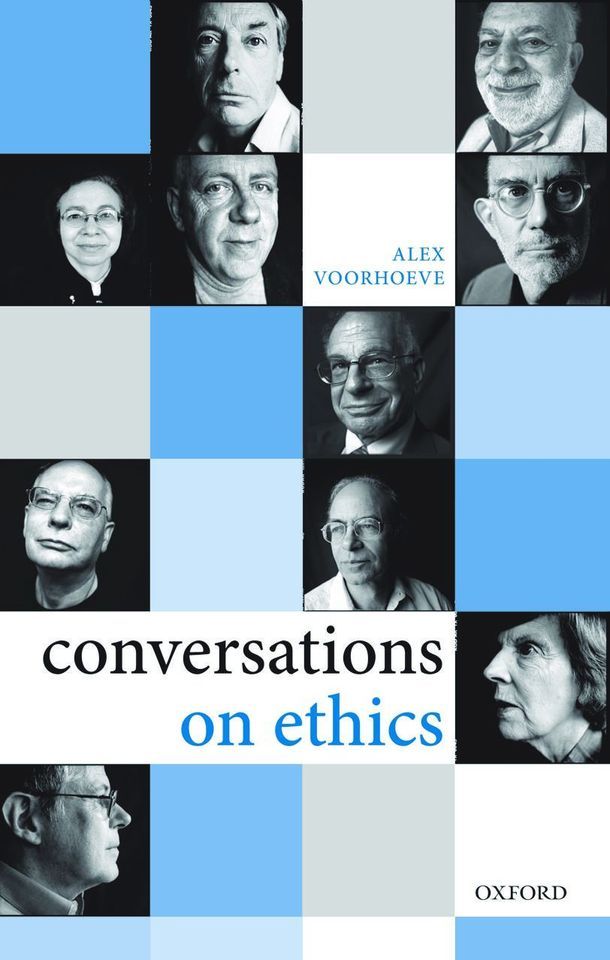
5 Facts about the Philosopher of the Month: Philippa Foot (1920–2010)
In recognition of the enormous contributions made by women to the field of philosophy, we honour Philippa Foot, one of the most distinctive and influential moral philosophers of the twentieth century, well-known for her work on virtue ethics. Foot challenged the moral orthodoxy of her time and contributed to the revival of Aristotelian ethics in contemporary philosophy, the theory of ethics developed by Plato and Aristotle that emphasizes the virtues, or moral character of the person carrying out the action rather than the duties or the consequences of actions. Here are five interesting facts about her life:
Despite having no formal education as a child, Foot succeeded in obtaining a place at Somerville College, a women’s college within the University of Oxford after taking a correspondence course in Latin.
She was one of the remarkable group of women, including Elizabeth Anscombe, Mary Midgley, and the future novelist Iris Murdoch, who studied at Oxford University during the Second World War and developed a shared philosophical viewpoint on moral philosophy.
Foot was a supporter of Oxfam since its early day, beginning as a volunteer sorting clothes into sacks, and later sitting on numerous Oxfam committees.
She believed that goodness should be seen as the natural flourishing of humans and that virtues are qualities beneficial to the possessor and the community.
Foot held a number of visiting professorships in the United States – at Cornell, MIT, the Universities of California (both UCLA and Berkeley), Washington, Princeton, and Stanford, and City University of New York.
#potm#philippa foot#philosopher of the month#philosophy#moral philosophy#virtue ethics#Aristotelian ethics#Oxfam#Women's History Month
92 notes
·
View notes
Text
Priority Research 7 Predictions - Iris Orthodoxy
Ah, the Iris. At the time of writing this post, we don't quite know if they're the CN 7th Anniversary faction or not, meaning they could be getting a gacha UR.
In this list I will also mention some possible DRs of them. Because I think they deserve more than what they already have - no offense to Brest enjoyers, she's very cool.

Colbert
Let's make one thing very clear:
Colbert was built in Brest in the 1960s, and served until 1972 as a light cruiser. Colbert did exist in real life, which would disqualify her from being a PR; however, she served at the beginning of the Cold War period, meaning I do not care.
Colbert was designed as an AA cruiser, the last of the ships France would classify as "cruisers" before adopting the term "frigate" for them.
She has a total of 16 low calliber 127mm guns in 8 turrets, guns which have a sub-4s reload time and have a considerable fire starting chance of 7%. Might not seem like much, but when you're getting bombarded with around 270 of these shells per minute, that quickly adds up.
Colbert could make for a very fun little DR light cruiser, even if realistically she will never be a PR.

Bourgogne
Talking about DRs, Bourgogne is a classic.
Being a sidegrade to Alsace at one tier higher (Tier 10), Bourgogne is an excellent pesky battleship. As usual with French battleships, she gets an engine boost; and if Alsace is anything to go by (I don't have Bourgogne lmao), she can easily reach 39 knots.
Her 12 380mm guns have a reload of 28s, to compensate for their low calliber at such a high tier; on top of having each a 36% fire starting chance. She's not quite HMS Conqueror or HMS St. Vincent levels of cringe, but she can be an HE spammer with no problems.
And if an enemy ship gives you a tempting broadside, her AP is not disappointing. Despite the low calliber, French shells are fast and hit hard.

Picardie
I sincerely hope we do not get Picardie in Azur Lane. She's utterly disappointing.
Picardie is a Tier 8 retrofit of Lyon, which swaps her perfectly fine and usable 340mm guns with pathetically weak 305mm guns. They have awful HE and AP penetrations, and not even her reload boost can save her.
However... Azur Lane has a track record of turning disappointing WoWs ships into fascinating PR shipgirls, so there's some hope.
PR rarity, of course. Just look at her bruh

Carnot
Certainly one of the ships of all time. Carnot is a supecruiser, much like Brest; but she's considerably different in terms of design. She has, for starters, ten 305mm guns; which is the most any supercruiser her tier has - Alaska, Ägir, Kronshtadt have 9, Siegfried has 6 (albeit 380mm), and Brest has 8. Her reload is subpar, however; at 22 seconds.
Her speed is very good, as it's mandatory of all French ships. Her armor is way too big to be good, as her deck sits high above the waterline, giving her plenty of large, flat, mediocre armor. Easy to penetrate with sufficiently large guns.
She works well as a PR, although I can see her being a DR as well.

Henri IV
Henri IV is the primordial French supercruiser. She's technically still just a heavy cruiser, armed with 240mm guns.
Once the queen of speed, Henri was nerfed to the ground a few years ago. Now, her acceleration speed is horrible, and her turning radius and rudder shift have also been nerfed, making her considerably less maneuverable.
Still, Henri IV could be an interesting older sister to Saint Louis; maybe even a DR.

Condé
While I'm not sure about Henri IV's rarity, I am certain Condé would be DR.
Condé is a bigger, better Henri IV, with quadruple 240mm gun turrets and access to a speed boost, a gun reload boost, and a burst fire mode which allows her to fire her guns every 1.5s for 2 salvos.
Condé is very good with what's known as a lighthouse build, which consists of making her as visible as possible.
The problem with Condé is the same as Yamagiri from the Sakura Empire prediction post - she's a Tier 11, and we have not gotten any Tier 11 yet. However, Condé is one of the most well known and beloved/hated Tier 11 ships, meaning she's way more popular.
10 notes
·
View notes
Text
the hierophant: tradition, conformity, education, knowledge, orthodoxy
aspen: excess of sensibility
purple iris: intelligence, wisdom
lan qiren is the obvious choice for the hierophant - a strict and respected spiritual elder and scholar who places value on orthodoxy. he is practically a walking representation of tradition in the show
like with all cards in this deck, I have to decide how to balance the moral/emotional associations and consequences of events in the actual story, with the fact that so few tarot cards have strictly, rigidly "negative" or "positive" connotations. in actual tarot, you are asking the cards for guidance, and they are answering with questions you need to explore for yourself. the original hierophant card expresses value in tradition and orthodoxy - the guidance it gives is that perhaps you need to look to wisdom and tradition for answers. I chose to lean into the moral implications of the story rather than the card - here orthodoxy is suffocating and harmful. lan wangji does not receive wisdom from lan qirens traditional mindset, instead it stifles him
the hierophant is meant to be the masculine counterpart to the high priestess. where lan yi is a guiding, helpful cautionary tale for wangxian, lan qiren is the repressive, staunch obstacle to their relationship
purple irises are also in the magician card. the cleverness of innovation vs the wisdom of tradition
originally I wanted to make lan qiren look very "historically accurate" as opposed to the sweeping dramatics of xianxia, but quickly realized that this is sort of an impossible task when cql and often xianxia in general aren't really based on a specific time period, so what is "historically accurate" for a culture with literal Thousands of years of fashion history? I ended opting for just making his clothes more practical/realistic. he ends up looking a little out of place but it fits, like your grandpa who isn't up to date on current fashion
in the same vein as lan qiren's more "practical" clothes, I made the imagery of the card more realistic - the flowers are in vases and the trees are outside the window
I tried to make lan wangji look very young and small here, crushed under the weight of a rigid establishment and the expectations placed on him by tradition and, by extension, lan qiren
the bamboo stick lan qiren is holding is a representation of the ways the orthodoxy of the lan sect is inflicted upon lan wangji

v. the hierophant
id in alt / cql major arcana cards
97 notes
·
View notes
Text

... The smallest wallscroll I own, lmao.
#azur lane#enterprise#belfast#アズールレーン#wall scroll#amazon#eagle union#iron blood#sakura empire#royal navy#sardegna empire#dragon empire#iris orthodoxy#northern parliament#jrpg#anime#mobile jrpg
4 notes
·
View notes
Text
Mary Midgley
Mary Beatrice Midgley (née Scrutton; 13 September 1919 – 10 October 2018[1]) was a British philosopher. She was a Senior Lecturer in Philosophy at Newcastle University and was known for her work on science, ethics and animal rights. She wrote her first book, Beast And Man (1978), when she was in her fifties. She went on to write more than 15 other books, including Animals and Why They Matter (1983), Wickedness (1984), The Ethical Primate (1994), Evolution as a Religion(1985), and Science as Salvation (1992). She was awarded honorary doctorates by Durham and Newcastle universities. Her autobiography, The Owl of Minerva, was published in 2005.
Midgley strongly opposed reductionism and scientism, and any attempts to make science a substitute for the humanities—a role for which it is, she argued, wholly inadequate. She wrote extensively about what philosophers can learn from nature, particularly from animals. A number of her books and articles discussed philosophical ideas appearing in popular science, including those of Richard Dawkins. She also wrote in favour of a moral interpretation of the Gaia hypothesis. The Guardiandescribed her as a fiercely combative philosopher and the UK's "foremost scourge of 'scientific pretension.'"[3]
She writes that her career in philosophy may have been affected by women having a greater voice in discussion at the time, because many male undergraduates left after a year to fight in the Second World War: "I think myself that this experience has something to do with the fact that Elizabeth [Anscombe] and I and Iris [Murdoch] and Philippa Foot and Mary Warnock have all made our names in philosophy... I do think that in normal times a lot of good female thinking is wasted because it simply doesn't get heard."[6]
"I wrote no books until I was a good 50, and I'm jolly glad because I didn't know what I thought before then."[3]
Gaia and philosophy
Midgley was supportive of James Lovelock's Gaia hypothesis. This was part of her "principal passion" of "reviving our reverence for the earth".[10] Midgley also described Gaia as a "breakthrough", as it was "the first time a theory derived from scientific measurements has carried with it an implicit moral imperative – the need to act in the interests of this living system on which we all depend.[20]
In 2001 Midgley founded, along with David Midgley and Tom Wakeford, the Gaia Network, and became its first Chair.[21][22] Their regular meetings on the implications of Gaia led to the 2007 book Earthy realism edited by Midgley, which sought to bring together the scientific and spiritual aspects of Gaia theory.[22]
Midgley's 2001 pamphlet for Demos Gaia: The next big idea argues for the importance of the idea of Gaia as a "powerful tool" in science, morality, psychology and politics, to gain a more holistic understanding of the world.[23]Instead, Midgley argued that we "must learn how to value various aspects of our environment, how to structure social relationships and institutions so that we value social and spiritual life, as well as the natural world, alongside commercial and economic aspects.[23]
Her book Science and Poetry, also published in 2001, also includes a discussion on the idea of Gaia, which she argued "is not a gratuitous, semi-mystical fantasy", but instead is "a useful idea, a cure for distortions that spoil our current world-view."[24] It is useful both in finding practical solutions to environmental problems and also in giving us "a more realistic view of ourselves".[24] Gaia has, Midgely argued, both scientific and moral importance, which also involves politics.[25] There is also a religious angle to Gaia.[26]
------
On reductionism and materialism[
edit
]
Beast and Man was an examination of human nature and a reaction against the reductionism of sociobiology, and the relativism and behaviorism she saw as prevalent in much of social science. She argued that human beings are more similar to animals than many social scientists then acknowledged, while animals are in many ways more sophisticated than was often accepted.[9] She criticised existentialists who argued that there was no such thing as human nature and writers such as Desmond Morris who she understood as arguing that human nature was "brutal and nasty".[9] Instead, she argued that human beings and their relationship with animals could be better understood by using the qualitativemethods of ethology and comparative psychology, and that this approach showed that "we do have a nature and it's much more in the middle.[9]
Midgley argued against reductionism, or the attempt to impose any one approach to understanding the world. She suggests that there are "many maps, many windows," arguing that "we need scientific pluralism—the recognition that there are many independent forms and sources of knowledge—rather than reductivism, the conviction that one fundamental form underlies them all and settles everything." She writes that it is helpful to think of the world as "a huge aquarium. We cannot see it as a whole from above, so we peer in at it through a number of small windows ... We can eventually make quite a lot of sense of this habitat if we patiently put together the data from different angles. But if we insist that our own window is the only one worth looking through, we shall not get very far."[31]
She argued that, "acknowledging matter as somehow akin to and penetrated by mind is not adding a new ... assumption ... it is becoming aware of something we are doing already." She suggested that "this topic is essentially the one which caused Einstein often to remark that the really surprising thing about science is that it works at all ... the simple observation that the laws of thought turn out to be the laws of things."[32]
Midgley wrote her 2014 book, Are you an illusion? as a response to Francis Crick's argument in his book The Astonishing Hypothesis that a person's sense of personal identity and free will is no more than the behaviour of nerve cells. She attacks the understanding inherent in this argument that everything, including a sense of self, can be understood through its physical properties.[9] Instead, she argues that there are different levels of explanation, which need to be studied using different methods. This means that thoughts and memories are an integral part of reality for both humans and animals and need to be studied as such.[33]
The bad feeling between Dawkins and Midgley appeared not to diminish. In a note to page 55 in the 2nd edition of The Selfish Gene (1989), Dawkins refers to her "highly intemperate and vicious paper." Midgley continued to criticise Dawkins' ideas. In her books Evolution as a Religion (2002) and The Myths We Live By (2003), she writes about what she sees as his confused use of language—the sleight of hand involved in using terms such as "selfish" in different ways without alerting the reader to the change in meaning—and some of what she regards as his rhetoric ("genes exert ultimate power over behaviour"), which she argues is more akin to religion than science. She wrote in a letter to The Guardian in 2005:
[There is] widespread discontent with the neo-Darwinist—or Dawkinsist—orthodoxy that claims something which Darwin himself denied, namely that natural selection is the sole and exclusive cause of evolution, making the world therefore, in some important sense, entirely random. This is itself a strange faith which ought not to be taken for granted as part of science.[38]
In an interview with The Independent in September 2007, she argued that Dawkins' views on evolution are ideologically driven: "The ideology Dawkins is selling is the worship of competition. It is projecting a Thatcherite take on economics on to evolution. It's not an impartial scientific view; it's a political drama."[39] In April 2009 Midgley reiterated her critical interpretation of The Selfish Gene as part of a series of articles on Hobbes in The Guardian.[40] In her 2010 book The Solitary Self: Darwin and the Selfish Gene, she argues that "simple one-sided accounts of human motives, such as the "selfish gene" tendency in recent neo-Darwinian thought, may be illuminating but are always unrealistic."[41]
0 notes
Text
Azur Lane spoilers
So uh.
What will they do now
With the whole

Having two French factions?
You know, since now the Iris Libre and the Vichya Dominion are a thing of the past and the Iris Orthodoxy has reunited???
8 notes
·
View notes